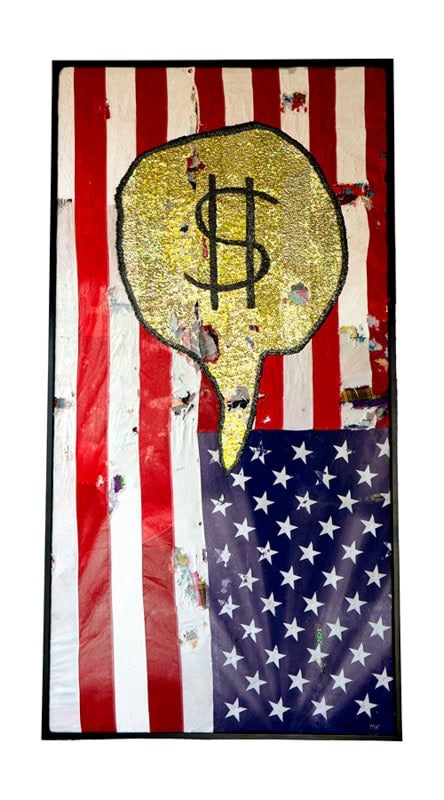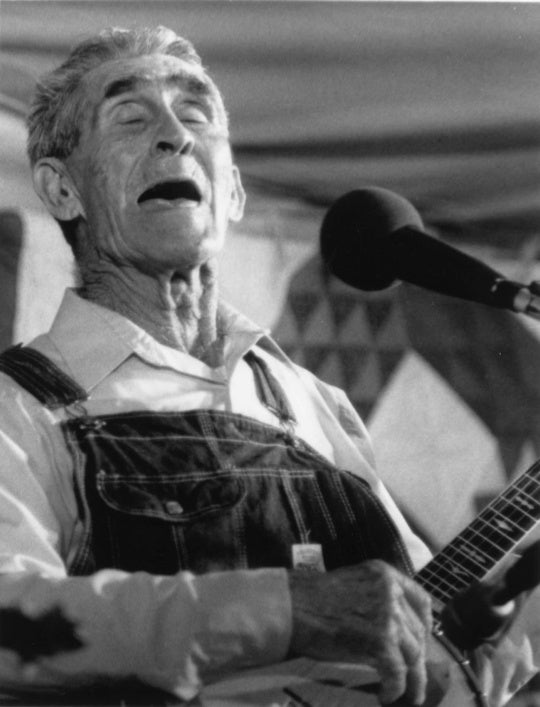
In Marcus Kenney’s “Babble,” on display at Marcia Wood Midtown through June 18, the darkened memories of our collective American past bubble up into abstracted, whimsical, and sometimes frightening imagery. Kenney’s paintings combine techniques of painting, printmaking, collage, and fiber art, as well as figurative and abstract brushwork. Throw his disco taxidermy into the mix, and you have the makings for a kooky show that leaves an unsettled feeling in the pit of your stomach.
As an artist, Kenney — a Louisiana native based in Savannah — is incredibly opaque. His dark and troubling images are not made easier to grasp by the stilted language he uses to wrap his work up in a mysterious aura. The artist statement for “Babble” is a song (poem?) called “DHOPE MAN COMING.” The opening lines say “sell me dirt in a bag sell me water in a jug, build fences for the animal poison for the bug.” I asked Kenney if he was inspired by Voodoo, Santeria, or other supernatural Coastal Empire histories. His response: “Scribble scrabble. It’s a mix of both. I’ve lived in both, so that’s the influence. Blood.”
All the works, from taxidermy to collage, are well constructed and very engaging. Careful observation will reveal themes and symbols permeating the show. Look for a single eye gazing down from the picture plane at the viewer. The mural-sized Tower of Babble (2014), one of first pieces that inspired this show, has an ominous collaged eye at the top of its cut-up pile. The eye appears in sculptures like Killing Time (2016), which looks like a rejected creature from a Stephen King novel. The first piece you see upon entering the gallery, eyeno (2016), has an eye at the center of mixed media rubble attached to a ping-pong table—complete with foreboding rusty tetanus-bearing nails that form rays around the arrangement.

Beyond the single eye, faces are altered and obscured in uncanny ways. At first, #2girls (2015) looks like an image of blackface. On closer inspection, the faces are of Caucasian girls cut out of a magazine and collaged over, one with a white mask, the other a black mask. Both Pilgrim (2016) and DHOPE MAN (2016) feature central figures with a black hood and cartoonish lips and eyes. Kenney, a straight white guy, just grazes the razor’s edge of racist imagery — none of it is outright problematic, but it clearly evokes such frightful figures.
As the centerpiece of this exhibition, Tower of Babble (2014) displays a masterful use of materials and techniques to create a narrative painting. Kenney layers a grid of bank receipts on the surface of the work, then paints and collages over them. The world Kenney creates is built on commerce, which changes the other symbols layered over the receipts. Flags of different nations, tall sailing ships, colonialists and natives—these elements appear to comment on the structures of capitalism. Deeper in the painting, Kenney reveals moments like a modern-day Hieronymous Bosch. There is a little boy with an oversized gun pointing at a girl who is revealing her panties, a businessman with a goat face copulating with a cow, and a policeman with a teddy bear head.

Kenney brings a great deal of care and effort to his surfaces, and everything in this body of work is intricately crafted. Old friends 4 sale (2016) features a large speech balloon on an American flag that simply reads “$.” From far away, the speech balloon looks like a large swath of yellow paint; however, up close the viewer sees it is actually thousands of hand-sewn gold sequins. The glitz of the sequins is a perfect contrast to the tattered flag, suggesting that money is the most valuable language of our nation. In Link (2016) delicate outlines of fleur-de-lis and curlicues are visible beneath a gentle patina of color. These shapes embedded in the painting look like pressed tin ceiling tiles, but they are actually marble dust the artist has imprinted into the canvas. The way Kenney creates effects on the surface of his canvas, then builds on top, adds depth and detail.
Despite Kenney’s wide-ranging materials and techniques in these disparate works, his consistent use of symbols and themes creates a cohesive whole. Symbols of Americana, money, and power are altered and humorously juxtaposed to critique the structures of capitalist society. Many of the images are challenging, possibly intentionally so, in our over politically correct art world climate. A superficial viewing may leave the viewer queasy and suspicious of Kenney’s intentions, but deeper inspection reveals that the artist uses loaded imagery to create even more powerful paintings. This is one show worth looking at intently, with an open mind, and an eagerness to explore. Kenney’s work reveals whimsical, dark, and often challenging narratives in beautifully packaged artworks.




